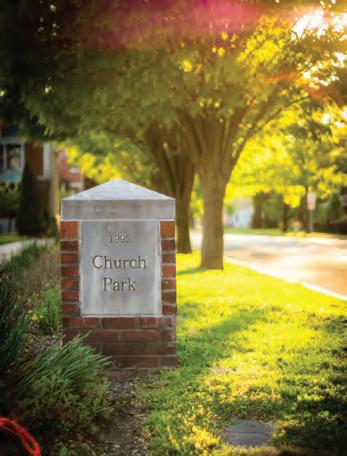
1 minute read
Worth the Drive
Good Living ARCHITECTURAL GEM P.20 SKATE GATE P.21 DOG DAYS OF SUMMER P.23
WORTH THE DRIVE
ROOFLESS CHURCH, DESIGNED BY PHILIP JOHNSON AND DEDICATED IN 1960
IN SEARCH OF UTOPIA

Explore the charm of Historic New Harmony
ATHENEUM, DESIGNED BY RICHARD MEIER AND OPENED IN 1979

THE REMNANTS OF NOT ONE, but two failed utopias still stand in New Harmony, Indiana, a historic town on the banks of the Wabash River that’s a 35-minute drive from Downtown Evansville. “When people look at a historic town, they don’t think about scientific advancements, equality, women’s rights, the abolitionist movements, but the reality is our two attempts at utopias were very advanced for that time,” says Historic New Harmony community engagement manager Claire Eagle. “Our history is much more interesting and more than you would expect to find in a small town in rural Indiana.”
This summer celebrates the 250th birthday of Robert Owen, founder of the second utopia attempt from 1825 to 1827. Owen, with business partner William Maclure, purchased New Harmony to create a scientific community that became home to some of the greatest geologists, scholars, and naturalists of the century.
The land was originally inhabited in 1814 by The Harmonie Society, a Lutheran separatist group led by George Rapp, until it returned to Pennsylvania and sold to Owen in 1824. Progressive societal standards and a focus on education and the arts from both founding groups allowed New Harmony to thrive after their departure.
In the 1960s, a descendant of Owen by marriage, Jane Blaffer Owen, brought the town into the modern age while preserving its history through the Robert Lee Blaffer Foundation (named for her father). From the Roofless Church, labyrinths, and meditation gardens, to the Atheneum and New Harmony Inn, she was involved in curating attractions.
The town also is home to Tri-State favorites such as Mary Scott’s Kitchen and Sara’s Harmony Way café and major regional events such as the annual Plein Air Out art competition.
“There’s absolutely something to do for everyone,” says Eagle. “There are shops, a huge playground, we have great food, and a huge history.”










